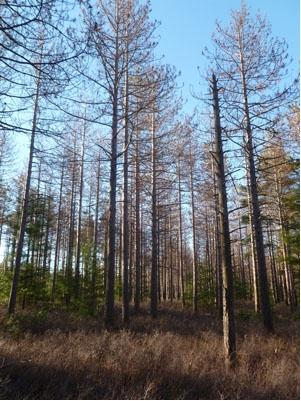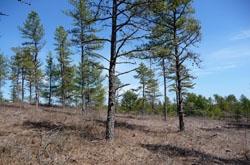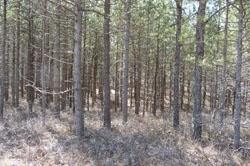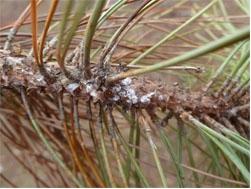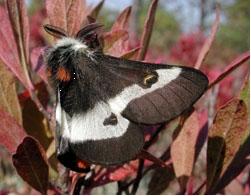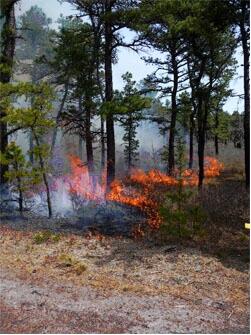Approximately 429 acres of dead and dying red pine was cut. Now that the red pine plantations have been removed, the Pitch pine and scrub oak are uninhibited and free to grow, returning these areas to pine barrens. The next step in our continuing process of managing this disturbance dependent ecosystem is to produce a forest wide fire management plan (FMP). The Myles Standish Planning Area FMP will be released in 2018.
Background
There were approximately 576 acres of planted red pine (Pinus resinosa) stands located throughout Myles Standish State Forest. Many of these plantations were planted after large wildfires. The largest section of red pine plantations occur in the western portion of the forest, which was planted after the 1957 fire. Norway spruce was also planted alongside red pine in a few instances.
The red pine in Myles Standish State Forest was infested by the red pine scale, (Matsucoccus resinosae) and diplodia blight (Diplodia pinea). The combined insect and fungus attack resulted in complete tree mortality.
Objective
The objective of the timber harvest was to complete an ecological restoration by allowing native vegetation communities of pitch pine and scrub oak, or Pine Barrens to flourish and provide habitat for a diversity of endangered species. Many plantations were established on former pine barrens habitat or are adjacent to existing pine barrens. The project protected public safety through the removal of red pine trees along roads, forest roads, hiking trails and paved bike paths. The project also reduced wildfire danger and now provides safe access to firefighters and fire apparatus. Non-native plantation removal was a high priority for pine barrens management in DCR's 2011 resource management plan.
Additional Resources
-
Open PDF file, 746.4 KB, Pitch Pine - Scrub Oak Community (English, PDF 746.4 KB)
Aesthetics
Whole tree removal and large clearing resulted in a dramatic change in appearance of the landscape. Visuals where harvesting occurred changed from a forest canopy to an open shrubland savannah. Because red pines were removed to promote native species of pitch pine, scrub oak, and shrubland species, the landscape view changed from a single species monoculture to a more diverse, multi-structured forest.
Red Pine Scale
Red pine scale is found throughout New England, New York, New Jersey, and eastern Pennsylvania. It was first reported in Connecticut in 1946 and was most likely introduced to the United States on exotic pines planted at the New York World’s Fair in 1939. Over the past few years it has spread across most of MA. The first visible signs of infestation include discoloration of the lower branches, followed by swift decline of the entire crown and rapid stand wide mortality. Red pine scale is a flightless insect that is spread by birds, squirrels, and the wind. The insects are not visible to the naked eye, but the females secrete a white, fuzzy protective covering called “flocculent”, which helps insulate the insect over the winter; it is the most visible sign of the insect infestation. The insects pierce the phloem of the bark and suck the moisture from the trees stressing them as if there was a drought. Once stressed, the trees are susceptible to secondary pests such as the Turpentine Beetle or the Whitespotted Pine Sawyer, which bore into the main stem causing additional stress and introduce other pathogens.
Rare and Endangered Species and Wildlife
Most of the Myles Standish State Forest is within the Natural Heritage Endangered Species Program (NHESP) priority habitats of rare species. The pitch pine-scrub oak barrens within MSSF provide habitat for a diversity of state-listed animals and plants, including 15 species of moths and butterflies, two tiger beetle species, and three species of plants. Most of these barrens species rely on habitat with an open vegetation structure, such as scrub oak shrublands and heathlands. A few of the “barrens” species prefer even more open habitat, perhaps more accurately described as savanna or sandplain grassland. Per the 2007 Biodiversity of Myles Standish State Forest report from NHESP, plantation removal of non-native species was the highest priority recommendation for pine barrens management.
Vegetation Management in Reserves
Whereas habitat manipulation, silvicultural treatments, and commercial harvesting operations are not typically permitted in Reserves, from page 20 of the Landscape Designations for DCR Parks & Forests: Selection Criteria and Management Guidelines “… some situations may call for ecological restoration and vegetation management. Situations where some management may be appropriate include the removal of invasive species or for the protection of existing rare species. Fire adapted Reserves in Southeastern Massachusetts may require active restoration and management to maintain habitat for rare species and reduce the risk of catastrophic wildfire that can threaten human health and safety.”
Post Pine Barrens Restoration Timber Harvest
Future silvicultural treatments will be prescribed burning, mowing, and a combination thereof to kill white pines that typically establish in such areas and to stimulate sprouting and growth of native shrubs. Active management using these methods will be planned in coordination with the NHESP, and done at variable frequencies and intensities to encourage a mosaic of pine barrens, shrublands, and woodland communities.
In the absence of disturbance, fire or mechanical, the vegetation components will rapidly move through succession, particularly the understory of scrub oak, huckleberry and blueberry. Where white pine is present, it may compete with pitch pine for growing space and eventually, after many years, dominate the site. This would be an undesirable condition, as the objective of this project was to return the rare Pine Barrens habitat and maintain it to provide for the rare flora and fauna that exist within it.
History of Plantations at Myles Standish State Forest
As a result of colonial wood utilization and wildfires, most of the original forest was cleared and burnt over by the mid-1800s. The Massachusetts Game Sanctuary Association initiated reforestation efforts in 1912 by planting 30,000 white pines around Barrett Pond and East Head Reservoir. In 1916, the State Forest Commission purchased the 5,700-acre Game Sanctuary Association property, creating Myles Standish State Forest (MSSF). By the end of the 1920s, the state had purchased the majority of the land we now know as MSSF. Today, MSSF has approximately 12,404 acres and is the largest public recreation area in southeastern Massachusetts.
After acquiring the land, the state continued the reforestation program over the next 40 years. With the help of state unemployed crews and Civilian Conservation Corps crews in the 1930s, approximately 1.9 million white, red, Austrian, jack and Scots pines, spruce, and other species were planted in the forest between 1916 and 1937. After the 1957 fire, several stands of red pine, white pine and Norway spruce were planted in the western portion of MSSF in an effort to reforest the area.
For additional information regarding the Pine Barrens Restoration timber harvest at Myles Standish State Forest, contact DCR Management Forester Paul Gregory at (508) 866-2580 ext. 121.
Additional Resources
-
Open PDF file, 502.72 KB, Pine Barrens Restoration (English, PDF 502.72 KB)
